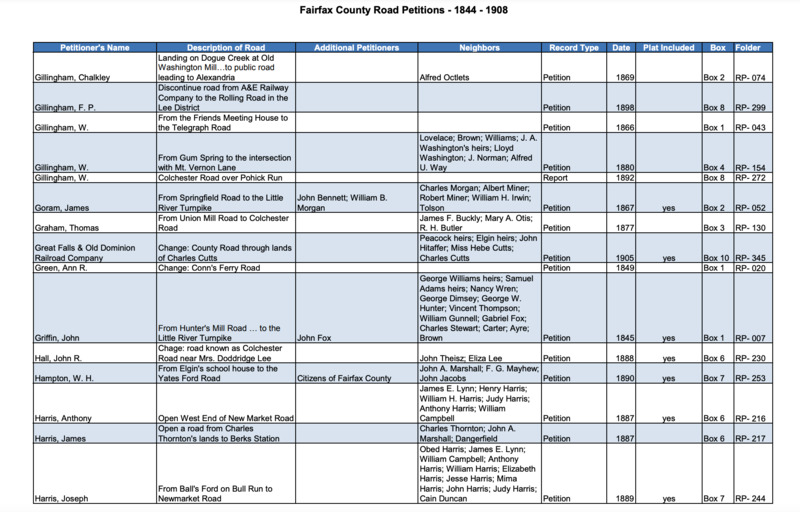After William H. Robinson's Life
When William H. Robinson died in 1908, his will was signed in 1916 where he had allocated his land to his children and wife. His daughter Elizabeth Robinson got lot 1, Vivian Robinson lot 2, his son Tasco T. Robinson lot 3, William E. Robinson lot 4, Burnett Robinson lot 5, and all remaining property as well as lot 6 for his wife, Sarah Robinson. These lots are in the Northern Providence District of Fairfax County, Virginia. A 1907 deed of trust for this area was done between Douglass S. Mackall and William H. Robinson where it was fully paid on February 20, 1911.
Within one of these lands that Sarah Robinson owned after William’s death, it was the 10 acres on Little Hunting Creek in Mount Vernon, Virginia. Sarah Robinson owned the land in Mount Vernon until in 1915 when she sold 0.5 acres to Fairfax County where they wanted to widen the road. The signer of the deed was I.R.R. Gillingham, a "Notary Public in and for the State and County." This last name will also be the same last name as the person who started the petition to widen the road.
The widening road project was petitioned by W. Gillingham. Cowing Road which went from Gum Springs to Mt. Vernon Lane, an existing road near Robinson's land. However, the project went through properties of Robinson’s neighbors such as Lovelace and Lloyd Washington, relatives of the Robinsons’ as well. While it was agreed that the road wouldn't fall into any ones' property, there is proof that Robinson sold .5 acres of her land, whether voluntarily or not.
The project was petitioned in 1880 and Sarah Robinson sold her .5 acres in 1910. This aligns with the early 1900s movement of road expansions that were happening all throughout Northern Virginia. While Mount Vernon was considered the southern part of Fairfax County, it was still within the Northern Virginian region.
In 1920, Fairfax County had an instance where their Board of Supervisors ordered an, “All Road Work Stopped, . . . owing to lack of money" (528). However, the people of Fairfax wanted differently as they approved, “ by a large majority a $500,000 bond issue for the improvement of the Little River Turnpike from Alexandria to Loudoun County” (Netherton, 528). This and the petition were early early signs of Fairfax civic engagement on advancing transportation services. As seen before, W. Gillingham may be a member representing the Fairfax County Board as someone with his last name also was assisting Sarah Robinson with her land deed.
In 1926, the first notice of an incorporation of a highway from Gum Springs to Mount Vernon was said (593). The focus areas for transportation were Washington, Alexandria.
The Byrd Road Act (1932) allowed counties to offer the transportation responsibilities (creating highways) to the highway commission which was The Public Road Administration, instead of the government. This gave states better freedom to control their transportation needs. Fairfax County reacted positively to this since this allowed them to focus more on their farmlands. For farmers within southern Fairfax, these improved roads meant greater prosperity selling and transporting their produce.
It wouldn't be long until I-495 was created where it would connect Alexandria and D.C. to the "growing Virginia and suburbs of Maryland" to increase businesses and government mobility within the Northern Virginia area (597).
Robinson, William H, and B.O. Grantt. “1742-1936, L-Z.” Essay. In Will Book Index, edited by J.O. Grantt, 77–79, Fairfax County Circuit Court Historic Records Center, Fairfax, Virginia.
Land Deed Book Index Y-7, Fairfax County Circuit Court Historic Records Center, Fairfax, Virginia. 328.
Fairfax County Road Petitions 1844-1908, Fairfax County Courthouse Archives, Road Petitions-154, Fairfax, Virginia
Netherton, Nan. Fairfax County, Virginia. Fairfax, VA, Fairfax, Va: Fairfax County Board of Supervisors, 1979.



